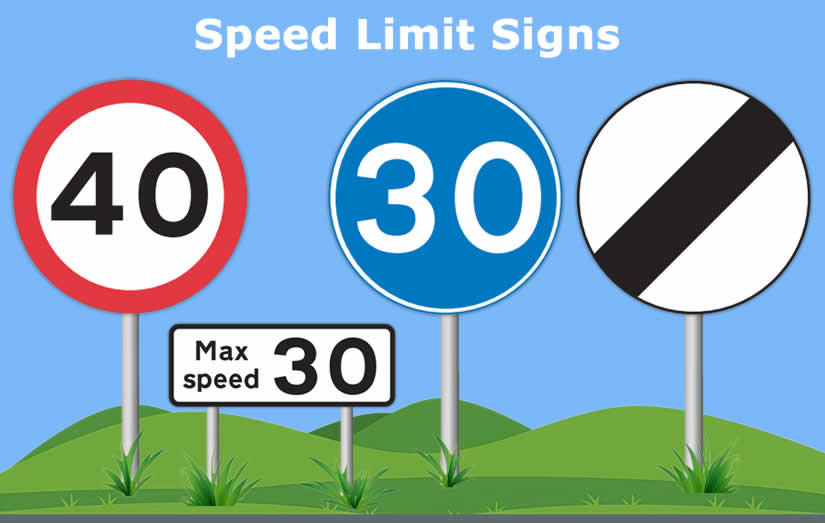As a new driver, one of the most common signs you’ll see in the UK are speed limit signs. Speed limit signs are literally everywhere and vary depending on the type of road and where the road is situated.
It pays to be aware of road signs, particularly speed limit signs as speeding accounts for the most common motoring offence in the UK. Throughout the UK, motorists paid an estimated £34.6 million in speeding fines during 2020.
The minimum penalty for speeding is a £100 fine and 3 penalty points added to your licence. For more severe speeding offences, the maximum fine for speeding is £1000 (£2500 on motorways) and 6 penalty points.
Circular Road Signs with a Red Ring
If you’ve an understanding of road sign shapes and their corresponding colour, then you’ll know that all circular road signs with a red ring provide mandatory instructions on what you must not do.
There are around 248,000 miles of road in Great Britain and most of these roads are in and around villages, towns and cities. Most of these are known as ‘B’ roads, or minor roads and many have a 30 mph speed limit.
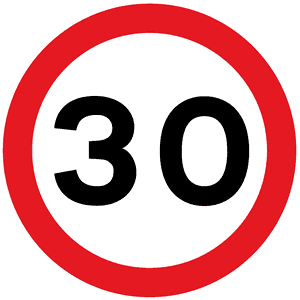
The 30 mph circular sign with a red ring is one of the most common regulatory signs and means that drivers must not exceed speeds of 30 mph. You’ll find 30 mph speed limits in most built up areas throughout the UK.
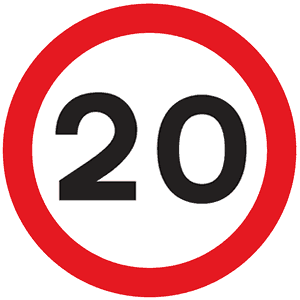
20 mph speed limits are increasingly being introduced into urban areas with high pedestrian density. You’ll often find that a 30 mph speed limit is reduced to 20 mph prior to entering town centres, high streets, roads outside of schools and certain residential areas. The reduced speed limit of 20 mph is safer for pedestrians, particularly children and help to reduce pollution.
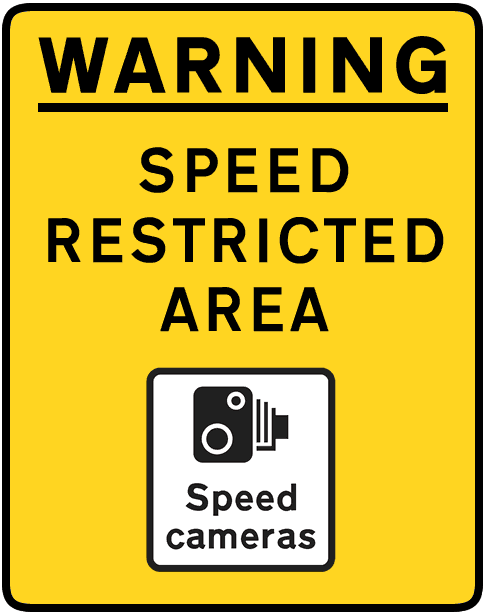
Prior to entering an area with a 20 mph speed limit, you may see the regular circular sign with a red ring. However, to make the lower speed limit more noticeable, other signs along with the regulatory 20 mph speed limit sign may be used to alert you that you’re about to enter a speed restricted area.
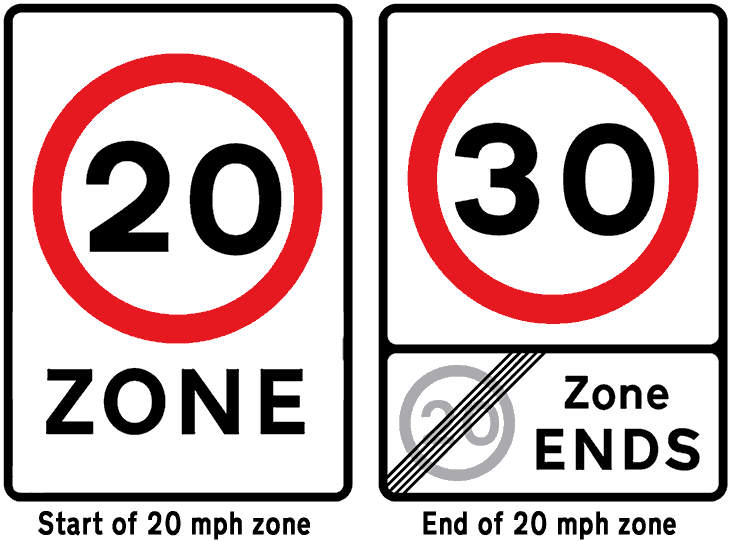
Larger speed restricted areas are called zones and rather than every road having speed limit signs in place, signs are placed prior to entering the zone that display the restricted speed limit. Within the zone, traffic calming measures are used such as speed cushions and road humps, chicanes, mini roundabouts and road narrowing, to reduce traffic speed.
As drivers are exiting the zone, signs will be in place indicating that the restricted speed zone is ending and the sign displays the new speed limit. Repeater speed limit signs are not always used in a restricted speed zone.
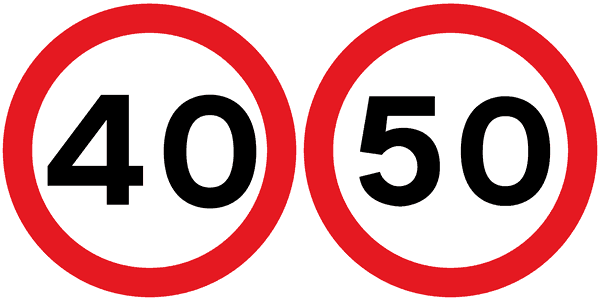
40 and 50 mph speed limit signs are usually located on roads that have higher traffic flow and that are not residential. The road will usually have frequent traffic lights, junctions or roundabouts that means they’re not suitable for the faster national speed limits.
Repeater Speed Limit Signs
Roads where the speed limit may be unclear, usually long roads with multiple junctions, repeater speed limit signs are often placed around 200 metres apart to keep driver’s informed of the current speed limit. Repeater speed limit signs are smaller versions of the main circular regulatory sign that you see at the start of the road.
National Speed Limit Signs
The national speed limit is the maximum legal speed for the type of road that you’re driving on and for the type of vehicle that you’re driving. We’re going to concentrate on cars only. The three different types of road in the UK are:
- Single carriageways
- Dual carriageways
- Motorways
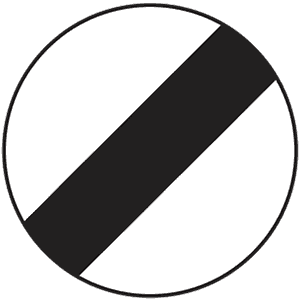
Single Carriageways
Single carriageways are where traffic flowing in both directions is not divided by a physical central reservation and instead, the opposing lanes are separated by white road markings. If you see a national speed limit sign on a single carriageway, it means the speed limit is 60 mph, or 50 mph if a car is towing a caravan or trailer.
However, just because a single carriageway has a national speed limit of 60 mph, doesn’t mean that it’s safe to drive at that speed. Many rural roads have a national speed limit applied to them, yet rural roads, per mile travelled are the most dangerous. Many rural roads are narrow with sharp bends and this combined with excessive speed means that cyclists, motorcyclists and car drivers are more than three times as likely to be involved in a fatal accident when compared to urban roads.
Dual Carriageways
A dual carriageway is where the opposing traffic lanes are separated by a physical divider called a central reservation. The central reservation is often a metal barrier. The national speed limit on dual carriageways is 70 mph (60 mph if a car is towing a caravan or trailer), unless speed limit signs state otherwise.
Motorways
As with dual carriageways, a motorway’s opposing traffic lanes are separated by a central reservation and the national speed limit on a motorway is 70 mph for a car, unless towing a caravan or trailer, then it’s 60 mph. The speed limit on a motorway will often vary depending on weather conditions and/or traffic congestion.
Always pay attention to the overhead digital displays called gantry signs. The gantry signs provide updated information on lane closures, recommended speed limits and mandatory speed limits.
Minimum Speed Limit Signs
Another type of speed limit sign that provides mandatory instruction are the circular blue minimum speed limit signs. The difference with minimum speed limit signs compared the maximum speed limit signs is that they provide instruction on what you must do.
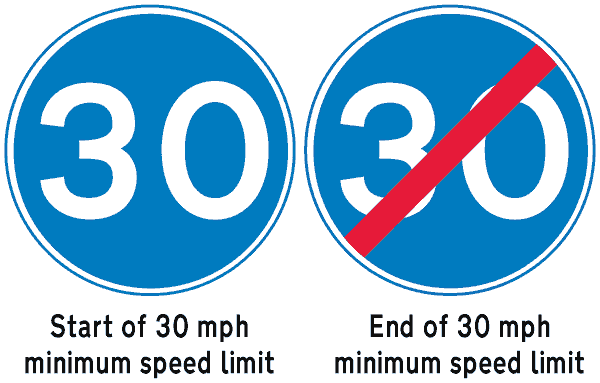
Maximum speed limit signs tell you that you must not exceed the speed limit displayed but minimum speed limit signs tell you that you must do at minimum, the speed limit displayed.
Minimum speed limits are not common in the UK, but you’re more likely to see the blue minimum speed limit signs just before entering a tunnel. Accidents in tunnels are particularly difficult for rescue workers to reach and by having minimum speed limits, it keeps traffic flow steady and consistent, lessening the chances of an accident.
Advisory Speed Limit Signs
Along with mandatory speed limit signs, there are also advisory speed limit road signs that are usually white rectangles. You’ll often find that advisory speed limit signs are incorporated onto the same road sign board as other signs.
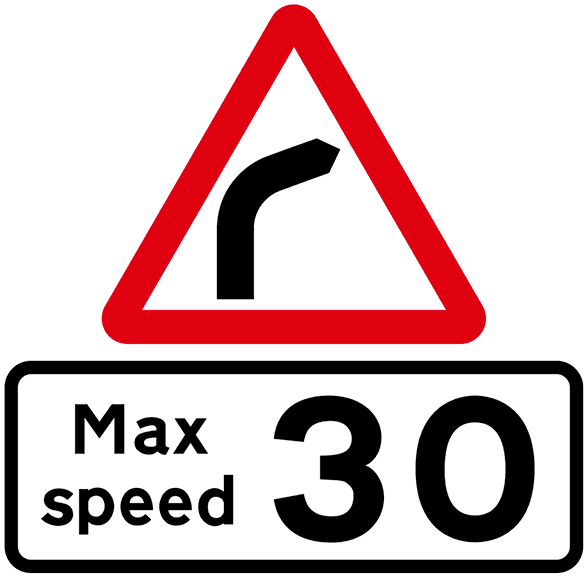
This advisory speed limit sign recommends a speed of no more than 30 mph due to a right-hand bend that’s ahead.
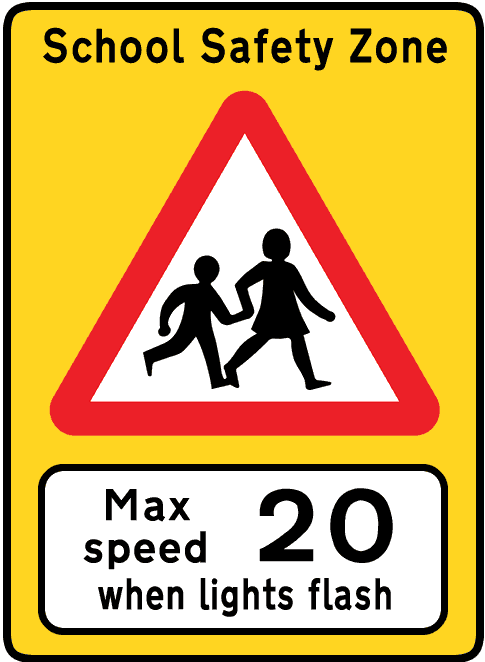
This advisory speed limit sign is located on a road where a school is situated. When school children are arriving or leaving school, amber lights will flash and during this phase, the sign recommends a speed limit of no more than 20 mph.
As we know, regulatory signs, (signs that give orders) are circles and as these signs are not circles, it means that it’s not illegal to disobey them. However, regardless of their legal status, you should use common sense to determine whether you should abide by the sign’s recommended speed limit.
Motorway Speed Limit Signs
The speed limit on a motorway is 70 mph for cars, unless stated otherwise. If there’s a reduced speed limit, it will be displayed on digital gantry boards on a bridge like structure over the specified lanes.
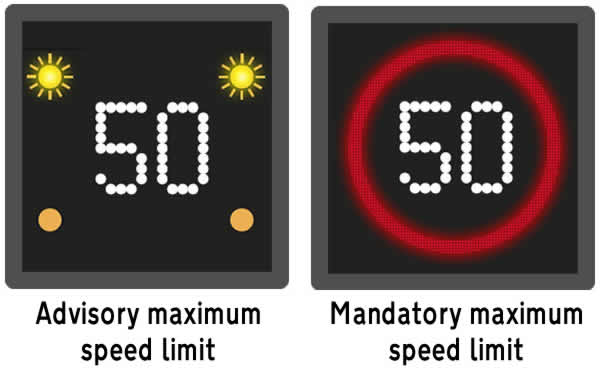
As we can see, the advisory motorway maximum speed limit of 50 mph has flashing amber lights. The mandatory 50 mph speed limit sign is circular with a red ring.
